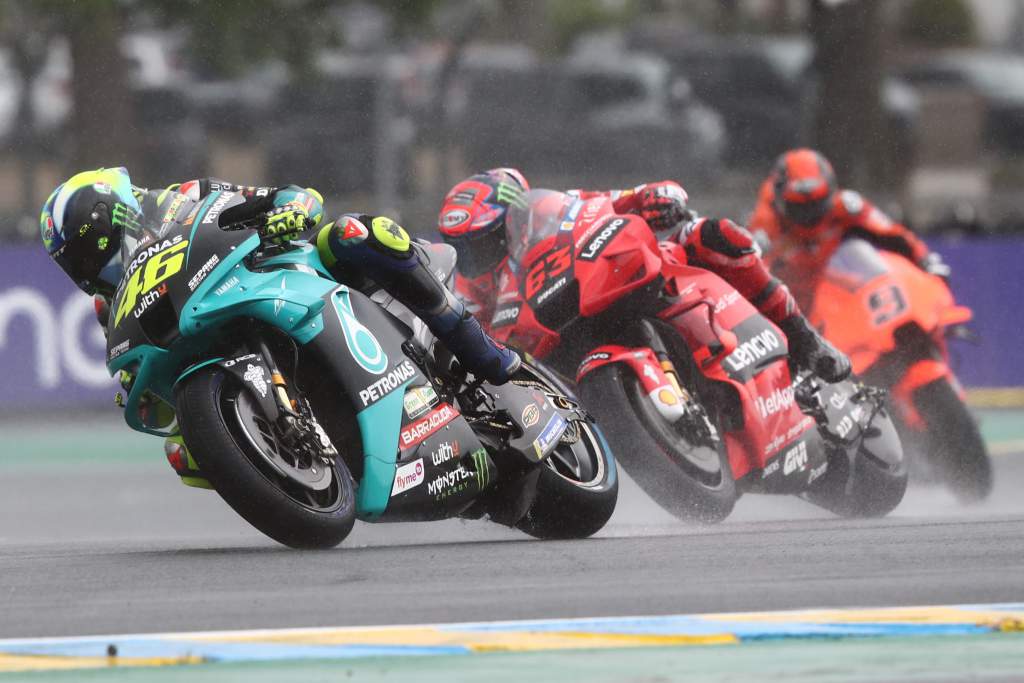For the first time since the 2017 Czech Grand Prix, we saw a MotoGP event descend into the organised chaos of a flag to flag race at Le Mans on Sunday, when rain only a few laps into the race led to the pitlane opening for riders to swap to their second machines and causing a flood of tension and nerves for the remainder of the French GP.
The flag to flag format’s been used since 2005, replacing the previous situation of red flags when weather changes and instead keeping races running and allowing riders to pit to jump onto second bikes fitted with the correct rubber for the conditions.
While the spectacle it provides for a TV audience is something unique to MotoGP, as it ramps up the drama even further, it creates a risk that almost feels like a step backwards in a championship that has worked hard to become as safe as possible in recent years.
“Personally I don’t like the flag to flag races, because they are more dangerous,” admitted nine-time world champion Valentino Rossi afterwards. “More than the stress, it’s more difficult and more dangerous.
“Sometimes you have to go with the slick tyres in the wet or the opposite. I prefer a longer 45-minute race where you can do your rhythm and use your strategy. Here, it’s more tricky.”
We saw exactly the risks of those conditions on Sunday, as a number of riders crashed out either as they entered the pits on slick tyres while it rained, or as they exited again on cold rubber and they did what racers do: immediately push. Thankfully, everyone escaped uninjured, but there’s sometimes a sense that that’s more to do with luck than design.
The format drives up the tension both on the track and off it and leads to stupid errors and mistakes. Fabio Quartararo pitted for his second bike into the wrong garage, Joan Mir forgot he had to bring his crashed Suzuki back to the pits and arrived on foot, Jack Miller and Pecco Bagnaia both received long lap penalties for speeding in the pitlane.
Yet here’s the thing: modern MotoGP racing is so close already that it really doesn’t need more tension added in. We’ve had some exceptional drama so far this year on the track, and it feels like it would be awfully mean if after a full season of ultra-competitiveness, someone lost out on a title due to the events of last Sunday at Le Mans.

In fact, traditionally flag to flag races become complete anathema to the closeness of the sport by making the racing more boring. Sure, there’s lots happening to entertain – but the on-track action is neutered by the huge time gaps caused by everyone entering the pits at different times.
We saw Miller and Johann Zarco catching Quartararo on Sunday – but when they caught him, they breezed past him and won by a big margin. There was none of the amazing battling that we saw in Qatar – or even that we saw at Le Mans up until the rain fell.
So why persist with the format if the riders brand it dangerous and it makes the racing duller? In a nutshell: TV. The flag to flag format ensures that wet races start on time, run to their allocated slot, and don’t crowd the all-important schedules of broadcasters.
Add to that that they produce dramatic moments perfectly designed to be chopped up and shared on social media, and it’s a perfect way to push the MotoGP to the masses – even if it does take away from the purity of it in the process.
The irony of Sunday is that if we had waited 10 minutes for the incoming rain – something that the organisers with their weather radar were well aware was coming – we’d have been able to start safely in wet conditions on wet tyres, and still had a brilliant race.
And yes sure, there’s an argument the track drying out towards the end would have meant changing conditions underfoot that would have caused an issue of its own. But it’s far safer to run a wet tyre on a drying track than a slick on a surface that’s getting wetter.

We saw just that earlier in the day, in fact, when Moto3 riders (admittedly with much less power) managed to control their degradation and make their wet Dunlops last until the end of the drying race while still giving us close racing.
Last year’s amazing Le Mans victory for Danilo Petrucci – in the wet all the way with no bike changes – wasn’t exactly dull, was it?




